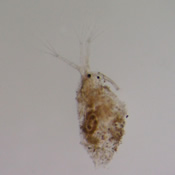| Ecology and Behavior | |||||
| Characteristics | |||||
|
|||||
| Geographic Distribution | |||||
|
|||||
| Reported Habitats | |||||
|
|||||
| Food and Feeding Behavior | |||||
|
|||||
| Locomotion | |||||
|
|||||
| References | |||||
(1) DODSON, S.I., and D.G. FREY. 1991. Cladocera and Other Branchiopoda, p. 723-786. In J.H. THORP and A.P. COVICH [eds.], Ecology and Classification of North American Freshwater Invertebrates. Academic. (2) DOOLITTLE, A. 1911. Descriptions of recently discovered Cladocera from New England. Proc. U.S. Nat. Mus. 41: 161-170. (3) FRYER, G. 1974. Evolution and adaptive radiation in the Macrothricidae (Crustacea: Cladocera): a study in comparative functional morphology and ecology. Philos. Trans. R. Soc. Lond., B, Biol. Sci. 269: 137-274. |
|||||
| Additional Pictures | |||||
|
|||||



